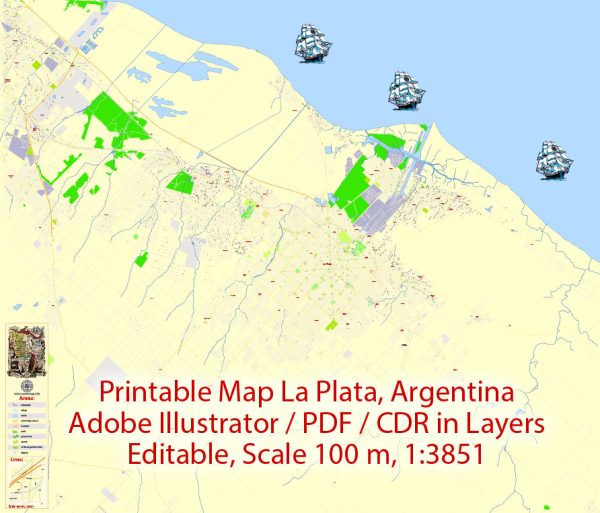La Plata is the capital city of the Buenos Aires Province in Argentina. It is located about 56 kilometers (35 miles) southeast of the city of Buenos Aires, the national capital. La Plata is known for its unique urban layout, cultural institutions, and architectural heritage.
Vectormap.Net provide you with the most accurate and up-to-date vector maps in Adobe Illustrator, PDF and other formats, designed for editing and printing. Please read the vector map descriptions carefully.
Here’s a detailed description of the city:
1. History: La Plata was founded in 1882 by Dardo Rocha as the provincial capital, aiming to create a city that would surpass Buenos Aires in cultural and educational aspects. The city’s name, which means “The Silver” in Spanish, reflects the region’s historical association with the Río de la Plata (River of Silver).
2. Urban Layout: One of the most distinctive features of La Plata is its well-planned urban layout. The city is designed in a strict grid pattern with wide avenues intersecting at right angles, reminiscent of other planned cities like Washington, D.C. The city’s central square is Plaza Moreno, surrounded by important buildings and landmarks.
3. Architectural Heritage: La Plata boasts a mix of architectural styles, including neoclassical, eclectic, and art nouveau. Notable buildings include the Cathedral of La Plata, a stunning neo-Gothic structure and one of the largest cathedrals in the Americas. The Teatro Argentino, an opera house, is another architectural gem.
4. Cultural Institutions: The city is a cultural hub with numerous museums, theaters, and educational institutions. The Museo de La Plata is a renowned natural history museum, featuring exhibits on paleontology, anthropology, and archaeology. The city is also home to several universities, including the National University of La Plata, one of the most prestigious in Argentina.
5. Parks and Green Spaces: La Plata is characterized by its ample green spaces and parks. The Paseo del Bosque is a large park that includes a zoo, a botanical garden, and a natural history museum. It provides a peaceful retreat for residents and visitors alike.
6. Education and Research: As a major educational center, La Plata is home to various research institutions and universities. The city has a strong academic presence, contributing to its vibrant intellectual and cultural atmosphere.
7. Economy and Industry: La Plata’s economy is diverse, with industries such as food processing, metallurgy, and chemical production. The city’s strategic location near Buenos Aires contributes to its economic importance.
8. Transportation: The city is well-connected by road and rail, making it accessible from Buenos Aires and other nearby cities. Local transportation within La Plata includes buses and taxis.
In summary, La Plata is a city with a rich cultural heritage, architectural significance, and a focus on education and research. Its unique design, cultural institutions, and historical landmarks make it a distinctive and vibrant destination in Argentina.


 Author: Kirill Shrayber, Ph.D.
Author: Kirill Shrayber, Ph.D.